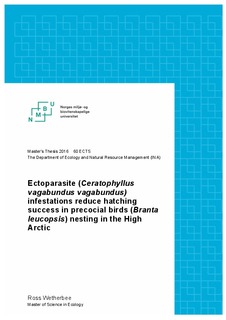| dc.description.abstract | Arctic terrestrial ecosystems are ideal systems to study host-parasite interactions because they are sensitive and have fewer confounding interactions than lower latitudes. Since the Arctic is experiencing rapid climate change, research there can provide models to better understand and predict future changes in other systems. The Barnacle goose (Branta leucopsis) and its ectoparasite the flea (Ceratophyllus vagabundus vagabundus) is an ideal Arctic host-parasite system to study because Barnacle geese have important roles in Arctic ecosystems as selective grazers and prey items and have been intensively studied for decades. Also, recent studies suggest that Arctic avian flea infestations may be increasing, possibly due to climate change. However, few studies have considered the effect of fleas on Arctic nesting birds and little is known of Arctic avian flea ecology, most importantly whether they overwinter in the High Arctic or are reintroduced each summer by migrating birds. Furthermore, sampling methods for avian fleas are time-consuming and semi-invasive to their hosts. Therefore, the project had four aims: (i) contribute to the knowledge of Arctic flea ecology by looking for evidence of overwintering, (ii) use an experimental study to assess the impact of flea infestations on the hatching success of Barnacle goose eggs, (iii) assess the simple and disturbance-free method of estimating fleas with photographs of blood spots on goose eggs, (iv) and test the results of both the experimental study as well as the application of blood spots as a proxy measure for flea infestations through a larger observational study. It was found that fleas were likely overwintering in empty nest bowls and some evidence indicated that they might be capable of a two-year life cycle in the High Arctic. The findings from the experimental study indicated that heavy flea infestations had a negative impact on the hatching success of Barnacle goose eggs. It was also determined that blood spots were a good proxy measure of flea infestations, but become less accurate through incubation due to wear from incubating birds. Finally, the observational study supported the findings of the experimental study and demonstrated the power and simplicity of using blood spots as a proxy measure for flea infestations. Based on these findings, it is suggested that researchers interested in either reproductive success or incubation behavior of Barnacle geese should include a measure of flea infestations in their studies and using blood spots as a proxy measure is a simple and disturbance-free method of doing this. | nb_NO |
